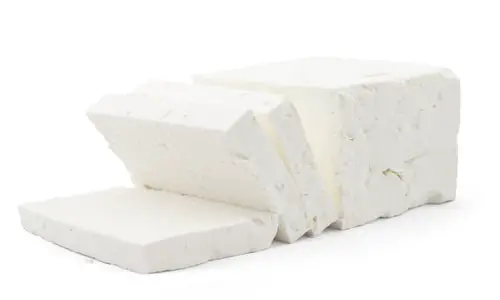Feta is a white, sheep’s milk cheese (also sometimes mixed with goat’s milk), that is used in salads, as a table cheese, and in many baked Greek dishes.
So, what happens when you go to your fridge to pick out your feta to make your favorite dish, only to find the cheese has mold growing on it ? Can you still eat moldy feta, what types of mold are growing and how can you stop this from happening again?
? Can you still eat moldy feta, what types of mold are growing and how can you stop this from happening again?
In this article, we answer all these questions and more, so, for all you need to know about mold on feta cheese, keep reading.

Can you eat feta cheese with mold?
No, eating feta cheese that has mold growing on it is not recommended, as it can cause allergic reactions and numerous health complaints in people with suppressed immune systems, even some otherwise healthy people could experience unpleasant effects from eating moldy feta.
When some strains of mold are disturbed or feel threatened in any way, they have the ability to produce mycotoxins as a defensive mechanism.
When ingested or inhaled via the molds’ spores, the mycotoxins can cause health complaints in many individuals, if the quantity is great enough.
Common symptoms of mold ingestion, allergies, or inhalation include:
- Breathlessness
- Coughing
- Runny nose
- Nausea
- Vomiting
- Gastrointestinal discomfort
- Skin irritation
These are only a few of the more commonly reported symptoms that people report suffering from. In extreme cases, liver damage and some cancers have also been reportedly linked to mold exposure.
Not all strains are toxic, so the variety growing on your feta cheese may be safe to consume, however, without accurate testing, it is very difficult to determine which strain you are dealing with, it is therefore always advised to discard any cheese with visible signs of mold growth.
Why does feta cheese become moldy?
Improper storage is the most common cause of feta cheese becoming moldy. Feta should be stored in a refrigerator at 40 degrees Fahrenheit or less to keep it as fresh as possible.
Mold can begin to grow rapidly once the temperature reaches between 60-80 degrees Fahrenheit, so leaving the cheese at room temperature for more than two hours will allow mold and bacteria to grow quickly.
The cheese provides the fats, proteins carbohydrates, and minerals that mold requires as a source of sustenance, it also has a higher moisture level than hard cheeses such as cheddar, which it can use for hydration.
If the correct temperatures are reached, the combination of adequate nutrition and hydration makes feta cheese a very inviting option for mold growth.
What types of mold grow on feta?
The most common types of mold found growing on feta cheese are penicillium strains. These strains are particularly hardy and can grow even at refrigeration temperatures, and so are commonly found growing on refrigerated cheeses, including feta.
Penicillium is generally considered to be non-pathogenic to humans, but it can cause serious reactions in those with suppressed immune systems or allergies. They are most commonly found growing within soil, on decomposing vegetables and fruits, wood, and some dried foods.
What does moldy feta cheese look like?
As penicillium is the most likely strain growing on your feta, you may notice small patches of white powdery or velvet-textured growth. Over time, these patches can turn blue, green, olive, yellow, or pink.
As mold can grow quickly under the correct circumstances, it can begin to grow within only two hours, however, it is likely that this would not be visible to the naked eye. After one or two days, small circular patches of growth would appear, with the mold gradually spreading over the remainder of the cheese within 1-3 days.
What is the blue mold on feta cheese?
Blue mold on feta cheese can be attributed to the penicillium strain of mold, as this commonly grows on cheeses and other dairy items.
Another, (although less common) strain that has the potential to grow on feta cheese, is aspergillus, as this can sometimes present with a blue hue, though it is more often seen in yellow to green coloration.
What happens if you eat moldy feta cheese?
If you were to accidentally eat a small amount of mold that was growing on feta cheese, you would likely suffer from little to no symptoms from the mold itself. However, it is important to note that again, people with severe allergies could suffer from serious health complaints if they ingested or inhaled mold or its spores.
The other factor to consider is that bacteria such as E. coli can often be found growing on cheeses at the same time as mold, which can cause food poisoning if ingested. It is for this reason that should you find your feta has begun to grow mold, it should be discarded.
Can you cut off the mold from feta cheese and eat the rest?
It is not advisable to remove the visible mold from the cheese and eat the remainder, as there could be a lot of mold still on the cheese that is not visible to the naked eye.
In semi-soft cheeses such as feta, mold can bury its roots (called threads) deeper into the top layer of cheese, spreading mycotoxins throughout. You could cut several inches of cheese away to prevent this from being an issue, however, the very act of removing moldy parts of the cheese could disturb the mold and cause it to spread its spores across the remainder of the block, creating new colonies.
How to prevent feta cheese from molding?
As we stated, poor storage is the number one cause of feta cheese growing mold prematurely. So, the following are steps you can take in order to store your cheese, prolonging its shelf-life and slowing the rate of mold and bacteria growth.
Keep the feta cheese in its brine
Feta cheese is stored in brine for two reasons, first, the salt in the brine acts as a natural preservative that creates an inhospitable environment for mold and bacteria growth.
The second reason is that the brine water acts as a barrier that prevents mold spores and bacteria from making direct contact with the surface of the cheese.
If you don’t plan on using the whole block of feta in one go, retain the brine the cheese came in. Once you have the cheese you want to store, pour it into an airtight container and make sure the cheese is fully covered.
Stored at the correct temperature and fully submerged in brine, the feta cheese should last for at least one month.
Store in an airtight container
Feta cheese can, of course, be kept in the packet it was purchased in, and without its brine, but in this state, the cheese will only last 5-7 days.
By placing the cheese in an airtight container (and preferably in its brine), you decrease the amount of available oxygen that mold needs to live, and so you take away one of its key components. You also decrease the chances of cross-contamination with other food items.
Stored in an open container, mold spores can find their way onto the cheese and settle to begin a colony, the lid on the container creates a barrier, keeping the cheese fresh and mold-free.
Store it towards the back of the fridge on the bottom shelves
Cheeses can be sensitive to changes in temperature that could affect their taste, texture and could increase the likelihood of mold growth.
Temperature fluctuations caused by opening and closing the fridge can slightly increase the temperature of the cheese, and as penicillium can already grow at refrigerated temperatures, warming the cheese even a few degrees can speed up its growth.
Place the cheese in an airtight container, covered in brine and store it towards the back of the fridge on one of the bottom shelves. This area of the fridge is more stable in terms of temperature and is affected less by temperature fluctuations from the fridge door being opened.
Check the expiration date
Even stored in brine or oil, feta cheese will have an expiration date. After this date has passed, the cheese will begin to turn rancid and is more likely to grow mold.
Before you purchase the cheese, make sure you will be able to use all of it before its expiration date has passed.
Store in oil if you’ve thrown the brine out
If you’ve thrown away the brine the feta cheese came in, you can use a mason jar and oil to preserve the cheese.
Place the feta cheese in the mason jar, and pour in the oil until the cheese is fully covered. You need to make sure the cheese is fully covered, as it is acting as a barrier that will prevent air from getting to it. Any oil will work, but a neutral one will have less of an impact on its flavor.
Kept in oil in a refrigerator, feta will last for two to three weeks.
Freeze it
Should you purchase far more feta cheese than you can use before its expiration date, you can freeze it to keep it fresh and protected from mold and bacteria growth.
Place the feta in a zip lock bag and remove as much air as possible before placing it in the freezer. The cheese can be frozen for up to one month before its texture and taste begin to deteriorate.
Conclusion
Semi-soft cheese such as feta mold more slowly than soft cheese, but faster than hard cheese due to their slightly higher water content. Poor storage practices are the most common cause of mold growth on feta and the most likely strain growing on the cheese is penicillium.
Keeping the cheese in its brine, oil, or freezing it will help to protect it against bacteria and mold growth.

